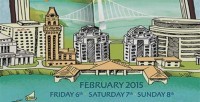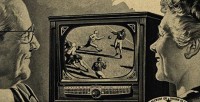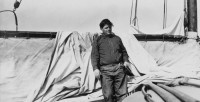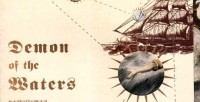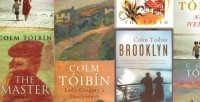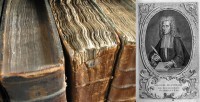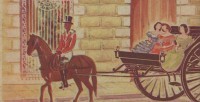We are just weeks away from the 48th California International Antiquarian Book Fair (February 6-8, 2015), the world's great Northern California rare book fair, and organizers have an extensive schedule of special events and seminars to surprise and delight both experienced collectors and those curious to begin. This year, the festival moves to a new location in historic Oakland, CA, affording easy access and superb facilities at the Oakland Marriott City Center. Along with exhibits by over 185 rare book dealers from the U.S. and abroad, there are many special events planned: Lecture by Daniel De Simone Saturday, February 7 at 1pm The ABAA and the Bibliographical Society of America are sponsoring a lecture on “Building New Audiences for Rare Books” by Daniel De Simone, Eric Weinmann Librarian at the Folger Shakespeare Museum. Educational Events for New Book Collectors Sunday, February 8 11:30am: Book Collecting 101 Learn how to judge a book's condition, where to buy quality rare books, the characteristics that distinguish a true first edition, how to shape a collection, and much more. 12:15 pm: What's This Book Worth? Professional appraisers will discuss the factors that give books commercial and monetary value. 1pm: Discovery Day Exhibitors will offer interested attendees up to three free appraisals, so if you think you may have an item of special interest, this is a valuable opportunity to have it assessed. "Jack London, Photographer": A Lecture by Sara S. Hodson Sunday,... [more 48th Annual California Antiquarian Book Fair]
We may be in the age of smart phones, tablet computers, and e-readers, but in sheer numbers, one household device still rules: television. Today in the United States, there are 2.86 TVs for every 2.5 people. More than half of U.S. households have three TVs. Yet the story of how television became ubiquitous in the American landscape remains mostly fragmented. There are several intertwining threads, including the narrative of technological development at individual manufacturers (especially RCA in the US), the development of appealing programming and a wide viewership, and the emergence of key institutions of contemporary market culture, notably mass advertising. Books and articles have been devoted to each of these, and there are a handful of institutions with excellent websites that provide further insight and documentation. (See here, here and here.) But an adequate history of the rise of television, and the consumer electronics industry itself, requires a comprehensive work of synthesis that so far has proved elusive. TV is a major component of the twentieth century American experience, shaping and reflecting both our own self-understanding, and the understanding of America around the globe. Surprising then that there seems to be relatively little collecting interest for printed materials from the years of television's incubation and infancy. In part this may be due to the technical nature of the story during the 1920s and '30s, in which improvements in electronic image cap... [more Collecting the History of Early Television]
Lost in transit: A signed Abraham Lincoln document appointing Christian Frederick Moller assistant Danish Consul in 1864. The document was framed and matted with portraits. See a rough image of the item here: http://www.bibliophagist.com/gscott/images/items/LincolnMoller.jpg Island Movers in Hawaii packed the item in its own custom wooden crate. One of the owners of the document saw the item packed. The crate was shipped from Hawaii on Oct. 10, 2014 (as part of a larger shipment of other household effects) to Northern California. The crate with the Lincoln document has not arrived, though the balance of the shipment arrived safely on December 12, 2014. If you are offered this piece or hear any information about the item, please contact Steve Gilley at (808) 497-7402. You can also contact Detective Andre Peters of the Honolulu Police Department Theft Detail at (808) 723-8902 (7:00 AM-3:45 PM HAST); refer to case 15002083. [more Missing in Transit: Abraham Lincoln Signed Document]
The 48th California International Antiquarian Book Fair kicks off on February 6, 2015. One of the keynote events at the fair is a presentation on Jack London's photography, by archivist and noted London expert Sara S. Hodson. Jack London (1876-1916) is now best known for stories and novels like The Call of the Wild and The Sea Wolf, as well as his many adventures as a sailor, Klondike gold-seeker, and rancher, but in the early years of the 20th century, he was a noted journalist and photographer, reporting from around the world for the Hearst syndicate. His negatives are now housed with the California Department of Parks and Recreation, and the Huntington Library holds 12,000 printed photographs. (ABAA members occasionally offer some of his photographs.) London's vivid, sensitive photographs capture the homeless of Great Britain in 1902, recording scenes of ragged men and women huddled on the park benches and harassed by police; battle images and portraits of freezing Korean refugees during the 1904 Russo-Japanese War; some of the first photos of the 1906 San Francisco Earthquake; the colorful life of the Hawaiian Islands and the South Seas photographed on the voyage of his sailboat, the Snark (1911); and the invasion of Vera Cruz in 1914. Wounded Japanese Soldier, Russo-Japanese War, 1904 Many of these images appeared in his newspaper and magazine stories as well as in his books The People of the Abyss (1903) and The Cruise of the Snark (1911), but few have been seen by many... [more Jack London, Photographer]
Years ago a colleague named Owen Kubik sent me an enigmatic manuscript. After considerable headscratching I determined it was the journal of a young naval officer sent to the Pacific to capture a sociopath who had committed murder and mutiny on the whaleship Globe. We sold it to the New Bedford Whaling Museum, and felt quite pleased with ourselves. Then it occurred to me that this manuscript would be an excellent frame for a new non-fiction book about the gory events aboard the Globe. Owing to the unexpected success of Philbrick's In the Heart of the Sea, there was a bull market for maritime non-fiction books that year. I wrote a cracking good proposal and sent it off to my agent. She loved it, and several publishers loved it (because it closely resembled a book that had already proved to be successful) but there was a catch. Another writer had already sold a proposal for a book about the Globe, and he was being represented by the same agency that represented me. The idea of the same agency representing two competing authors writing about the same thing created a minor scandal in the publishing world. Many people considered it unethical. My agent, God bless her, didn't care what anyone else thought. She was young and brave, and had her eyes on the future. She sold my proposal to Little, Brown for $150,000. The resulting book, Demon of the Waters, came out at about the same time as the other fellow's book and, to everyone's considerable surprise, the two books demolished one a... [more Used Books of the Future]
Reading resolutions are becoming more common. Following the VIDA report on the paucity of reviews for books by women versus books by men in national newspapers and magazines, a lot of people resolved to read only women authors in 2014. Others resolved to read only young adult fiction, or to spend a year re-reading their favorite books. I usually tread the well-worn path of reading whatever I feel like, and end up with mostly new fiction and nonfiction, with a few old favorites thrown into the mix -- along with whatever books my teenagers tell me are "really cool." This year, I've resolved to read all of Colm Tóibín's fiction, and as much of his nonfiction as I can manage. Why Colm Tóibín? Well to start with, I'm Irish, and primarily read Irish writers. Colm Tóibín has become perhaps the finest Irish novelist currently working, and maybe one of the finest in the world, scooping major awards for his fiction (The Master), seeing a play produced on Broadway (The Testament of Mary), and his novels are now being adapted by Hollywood (Brooklyn). For the longest time, I was resistant to reading Tóibín. He's a generation older than me, and I had the impression (wrongly) that many of his novels were about the Ireland of the 1950s, a stereo-typically repressed time that in my younger days I thought had little relevance for me, a modern Irishman, an emigrant-by-choice, and techno-savvy citizen of the world. As time went on, I realized contemporary Ireland is sadly not so very dif... [more Reading Resolution: The Year of Colm Tóibín]
To begin at the beginning, Charles Ralph Boxer was born in 1904 to a distinguished British family of considerable means. Educated at Wellington College and Sandhurst, he seemed destined for a military career following a family tradition that had seen Boxers serve in command positions in every British war since the French Revolution. He was posted to Japan in 1930 where he first developed his interest in Portuguese imperial history following the disastrous incursion into Japan in the 17th century. In 1936 he was sent to Hong Kong where by 1941 he was the chief army intelligence officer; wounded in the Japanese attack on Hong Kong he was captured and held as a prisoner of war until 1945 and his entire collection of rare Portuguese-related books was seized by the Japanese for the Imperial Library.* After his release he returned to Japan in 1946 where he was able to arrange for the return of most of his books, although a handful were never located. Before the invasion of Hong Kong he had prepared a catalogue of the collection, Bibliotheca Boxeriana, and in 1965 the Lilly Library of Indiana University purchased the entire remaining collection from Boxer – lacking the few missing books including one great rarity. In his catalogue he had recorded the existence of what is still thought to be the only known complete copy of the first edition of Figueiredo's “Hydrographia” 1608, surely the most important Portuguese manual on navigation of the late 16th-early 17th century and a ke... [more A Bibliophilic Miracle]
This week's news that President Obama will end the 54-year-old American trade embargo against Cuba and restore diplomatic relations marks a major change in Cuban-American relations. ABAA members have many fascinating items that chart the ebb and flow of American involvement in Cuba over the twentieth century, and a search for items relating to Cuba on our website can be a fascinating exercise. Members have documents signed by Fulgencio Batista, Fidel Castro, and Che Guevera, along with other participants on both sides of Cuban history. Letter signed by all Moncada prisoners, including Fidel Castro (1953) Archive of Documents relating to the Bay of Pigs invasion... Documents relating to Hemingway's time living in Cuba are enlightening, both for students of the great author's career and those interested in Cuban politics. Ernest Hemingway draft and corrected letters to Fulgencio Batista (part of a larger archive of Cuban interest) Members also have various editions of the classic Blue Guide to Cuba, a popular guide book to the pre-revolutionary island. Perhaps we'll see a new generation of those classic Cuban guide books once the travel restrictions are lifted. [more Cuba: Items of Historical Interest]
Update on Proposed Internet Sales Tax Legislation Internet Sales Tax—What is it? Presently, catalog and online sellers must collect sales and use taxes only in states where they have a physical presence. In states where sellers don't have a physical presence, the responsibility falls on consumers to pay a use tax directly to the states in which they reside. Since the vast majority of consumers don't do that, legislation called The Marketplace Fairness Act has been proposed to shift the responsibility from consumers to sellers by allowing states to collect taxes from out-of-state “remote sellers” that have no physical presence in their state. Where does the proposed law stand now? In May 2013 the Senate, but not the House, passed the Marketplace Fairness Act. The Act contains an exemption for small businesses and calls for states to provide free software to aide online sellers in tax collection. Under it, states cannot collect taxes from “remote sellers with annual gross receipts in total U.S. remote sales not exceeding $1 million in the preceding calendar year.” In response, Rep. Bob Goodlatte (R-Va.), the Chair of the House Judiciary Committee tasked with overseeing this proposal in the House, signaled his gross disapproval of the Senate's bill and issued his Seven Principles to guide drafting the House Bill. In December 2014, Goodlatte reaffirmed his position. What does this mean for my business? Two of Goodlatte's principles are relevant for members: Tech Neutral... [more Update on Proposed Internet Sales Tax Legislation]
Waste Not, Want Not: Social Media and Time Management When you are juggling an endless array of duties and priorities, as so many booksellers are, fitting yet another “thing” onto your already lengthy to-do list might produce the same effect as chopping onions. I would also bet that for many of us, when work gets extra stressful, social media is the first thing to go out the window. While dropping the ball happens to all of us on occasion, if I have done anything with these little blog posts, hopefully it has been to promote the idea that if you are engaging in social media, then it deserves the same commitment that you would put into other areas of customer care, such as answering inquiries promptly. Putting the soapbox aside now, there is one big distinction between your regular office duties and social media: social media is not confined to business hours. In effect, the clock never stops. How, ye gods, can one mortal keep up with such a beast?? Well, good news: being online 24/7 is impractical, not to mention physically impossible, so give yourself a break. Reaping the benefits of social media, contrary to what you might have been told, does not require you to be constantly plugged in. In fact, you would be surprised at what a small time investment can deliver. The trick is to get smarter about how you spend time online, and to know the difference between wasting your time and investing your time because believe me, it is all too easy to engage in the former while cla... [more THE SAVVY BOOKSELLER: Social Media for the Antiquarian Book Trade, Post #6]


